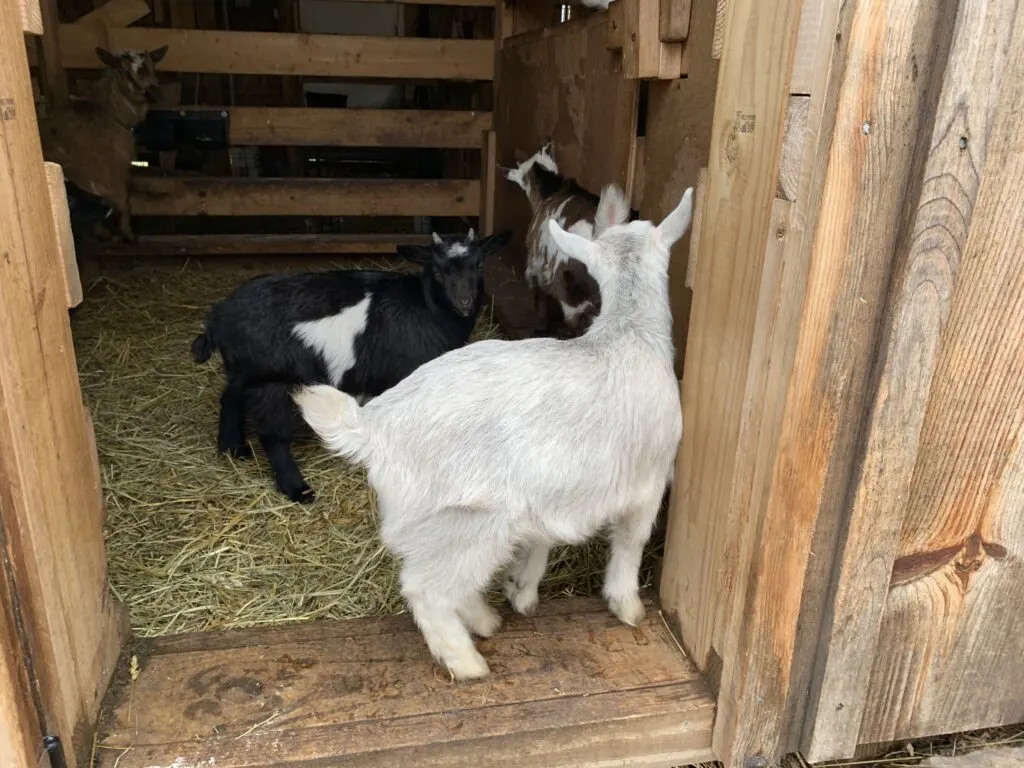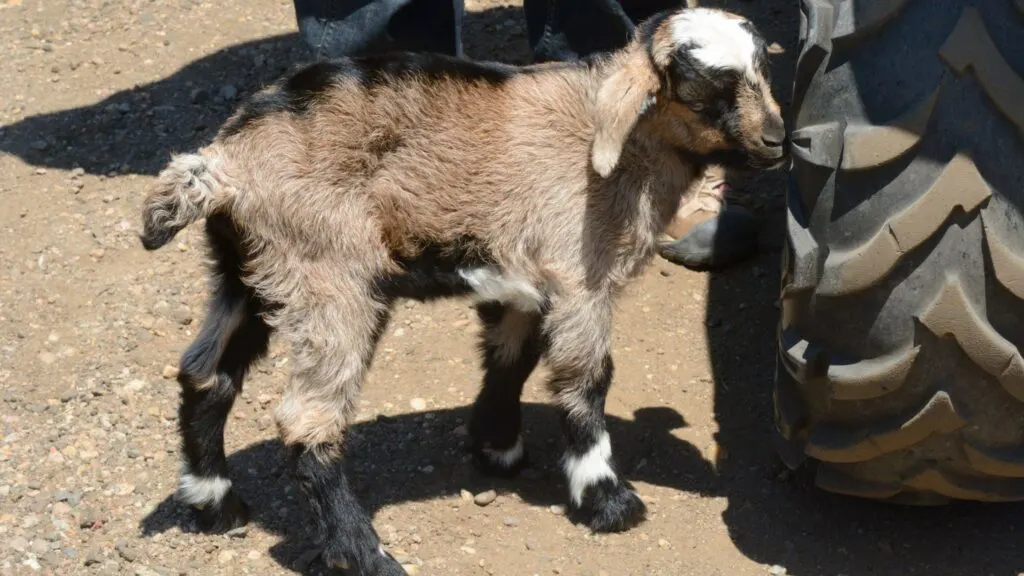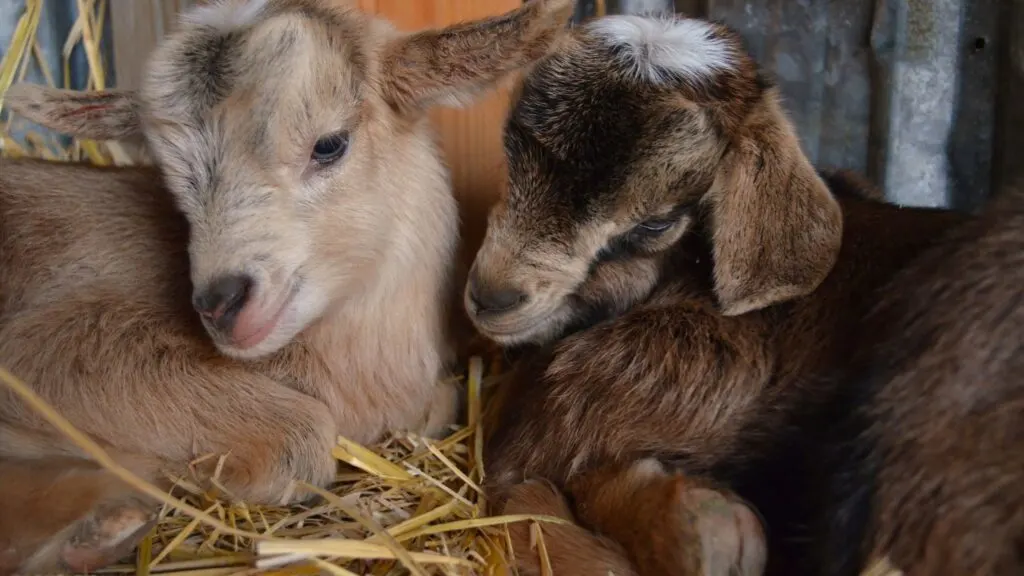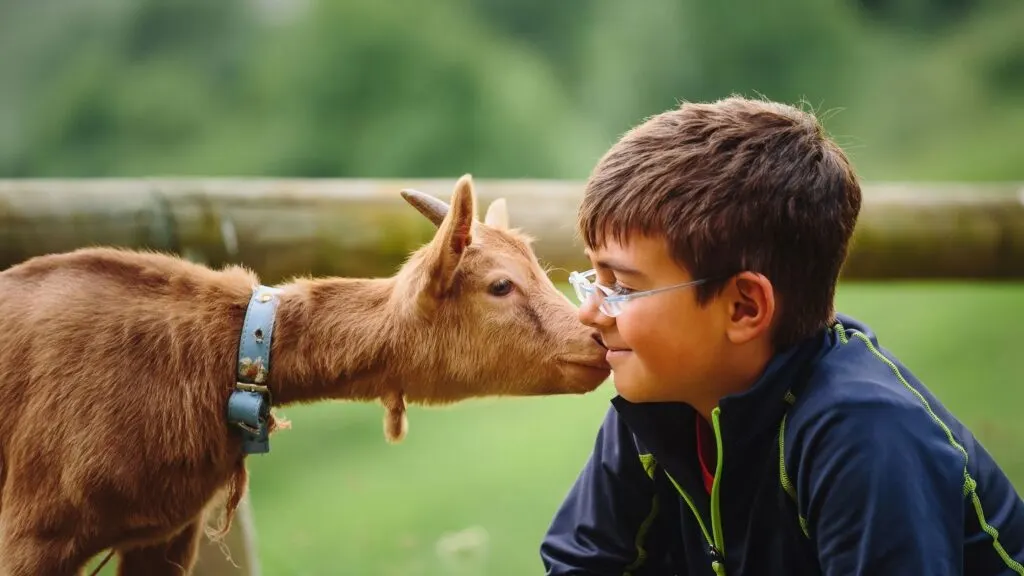I’ve always wanted a farm, and never had my heart set on goats, but now that I’ve had goats for over five years, I couldn’t image the homestead without them.
Raising goats is fun and rewarding and comes with a little bit more skill than starting with chickens. I love the personality of some of our goats and have learned they can also be quite naughty. My favorite part of raising goats for the past few years is the kids and the milk!
So, how do you pick the right breed? It depends on what you want to gain from raising goats on your homestead.
Let’s get into the goat world while I share my top picks for the best goats for beginners.

Best Goat Breeds
Nigerian Dwarf
So, you’re thinking of getting started with goat farming? Well, let me tell you about a super popular breed for beginners: the Nigerian Dwarf goat. These little fellas are the real deal!
Not only are they adorably tiny, but they’re also low maintenance and produce some top-notch milk. Perfect for those of us with limited space!
And let me tell you, they’ve got quite the personality too – always up for some fun and games. These pint-sized pals will fit right into your family!
Just remember, they might be small, but they still need some tender loving care and a good diet to stay fit and fab.

Trust me, the daily attention is worth it when you see those cute little faces staring back at you! This little goat above the girls named Minnow, and he was hard to let go.
Besides our Fainting Cross goats, we have all Nigerian Dwarf goats on our farm. I’ve seen plenty of fellow homesteaders go from breed to bred and most stick with Nigerian Dwarf because they are a great all round goat.
We have alot of success with this breed during kidding season and my Nigerian Dwarf/Fainter is a good milker!

Nigerian Dwarf goat milk tends to have a sweeter taste. For us, we don’t need a ton of milk, and milking two or three goats is plenty.
We were shocked at how simiular goat milk tastes to cow’s milk. I shared the girls blind tasting here. Follow along on Facebook for our goat adventures.

I started milking our first goats only a year and a half ago and shared my first experience on TikTok. The one thing we made first was ice cream with our KitchenAid mixer ice cream attachement. It was delicious!
Keep in mind if you are going to raise a goat for milk, you will need to “freshen” her every year. That means you will need a buck or know someone who will rent a buck to you for breeding.

Pygmy
Let’s talk about Pygmy goats a fan favorite of the minuature goat breed. They are actually champs in the milk goat world. These friendly goats are not only intelligent but also make delightful companions for any farm.
When we brought Oreo our wether home a lot of people said he looks like a Pygmy goat. He sure does but his size is alot larger now that he is full grown.
Forget about weather concerns because these goats can handle anything Mother Nature throws at them. From chilly winters to scorching summers, they’ve got it covered like pros.
Now, let’s address the tiny elephant in the room. Despite their name, Pygmy goats are pint-sized compared to other breeds. Picture this: they can reach a maximum height of just 15 inches and weigh in at a whopping 85 pounds.
But don’t let their miniature size fool you! These little powerhouses can produce an impressive amount of milk, perfect for even the coziest of households.
And guess what? These mini dynamos can stick around for a solid 12 years on average. That’s a long time for a goat, folks!
So, whether you’re looking for a milk supplier or a cute and fluffy friend, Pygmy goats have got you covered. They’re the pocket-sized, milk-producing wonders you never knew you needed.

Nubian
Nubian goats are known for their sweet and affectionate nature, making them a great choice for families with children. They’re a dairy breed that produces rich, creamy milk and can adapt to different climates and environments. They are a popular choice for a dual-purpose goat.
Nubians are excellent milk producers and or a good choice for goat meat. However, they require more space than other breeds of goats and tend to be vocal.
Raising goats for meat isn’t something we have personally ventured into yet. We instead raise lamb for meat and then the kids are also showing sheep in our local 4-H group.

LaMancha
LaMancha goats have distinctive ears that are either short and stubby or nonexistent. They’re a dairy breed that produces large quantities of milk with high butterfat and protein.
This breed of goat is known for it’s calm and docile personality. However, like any animal you are keeping they can become overweight leading to health problems. Keep in mind the bigger the animal the more space you will need as well as a larger budget for feeding/care.

Alpine
Alpine goats are one of the hardiest breeds, making them a great choice for beginners. They’re versatile, adaptable, and produce high-quality milk.
Did you know that adult does can produce a whopping 2,266 pounds of milk per year? That’s right, these majestic creatures are the perfect choice for beginners looking to yield some delicious goat milk.
And let’s not forget, Alpine goats are no joke in terms of size, standing at a minimum of 30 to 40 inches tall. That’s one big goat!
They also have a friendly disposition and come in a range of colors and patterns. However, they require a lot of space and proper shelter to live comfortably.

Saanen
Let me introduce you to Saanen goats – these big and beautiful creatures are like walking milk factories! Not only do they produce huge amounts of milk with a deliciously mild flavor, but they also have personalities as docile as puppy dogs.
And here’s the best part, they’re perfect for beginners because they’re so easy to handle.
But hey, all that milk production comes with a little upkeep. These glamorous goats need some regular grooming to keep their coats looking fabulous and as shiny as a disco ball!
Check out Saanen goats – they’re bigger than your average goat, standing at a whopping 30 inches tall (or even more)! These adorable creatures rock either a pure white or cream-colored coat of hair with wattles.

Boer
Let me introduce you to the Boer goats. These chunky meat goats hail all the way from South Africa. With their bulging muscles and insatiable appetite for growth, they’re like bodybuilders on a mission.
But don’t let their ripped physique fool you, they’re as easygoing as it gets. You can care for them with just a blink of an eye.
However, there’s one catch – they’re notorious escape artists. You better have top-notch fencing skills, or else they’ll be out and about exploring the world.
And while they may seem invincible, they have their share of respiratory issues, just like us humans do when we forget to cover our sneezes.
So, keep an eye on their well-being and give them some extra love and care.

Kiko
Let’s talk about Kiko goats – the hardy meat breed hailing all the way from New Zealand. These little fellas are pretty special, boasting a superhero-like immune system, lightning-fast growth, and an uncanny knack for finding tasty bites.
But here’s the catch – they’re low-maintenance and have the coolest, most Zen-like disposition you’ve ever seen. Now, don’t go confusing them with dairy goats, ’cause that’s not their thing.
And hey, if you don’t cook their meat just right, you might end up with a tougher chew. So, remember – Kiko goats, they’re the cool and captivating meat machines you never knew you needed.

Fainting
Have you ever heard of fainting goats? They’re these hilarious creatures, also known as Myotonic goats that make a great pet. And get this – when they get startled or excited, their muscles freeze up!
It’s like they’re playing a game of musical statues all the time. But don’t worry, it doesn’t harm them at all. In fact, it just adds to their entertainment value on a homestead.
You know what else? These goats are a breeze to take care of. They’ve got a friendly personality that’ll surely make you smile. However, don’t expect them to produce a ton of milk or meat. They’re more like the class clowns of the goat world.
But there is a catch when it comes to Fainting Goats. If you breed a fainting goat with let’s say Nigerian Dwarf, the kids will not faint. You need to breed them with another Fainting Goat. So keep that in mind, but they are super cute.
When I started on my goat-raising journey I was checking craigslist all the time and found two goats that were adorable. Yep, I was picking out goats on looks and price.
Look how cute they were when we brought them home.

The goats were Nigerian Dwarf/Fanting. One was a wether and the other a doe. I still have those goats today. They are a bit bigger than my pure Nigerian Dwarf goats, but Willow, the doe is an excellent milker and continues to have triplets each year.
Willow also has more of the longer hair like her Dam who was a 100% Mytonic goat. I breed Willow with our registered Nigerian Dwarf buck. They have beautiful kids don’t ya think?

Angora
Angora goats are a fiber breed that produces mohair, a luxurious and valuable wool. They’re hardy animals that can thrive in different environments and are known for their docile nature.
However, they require regular shearing and can be prone to health issues like parasites and hypothermia.
Nigora
Nigora goats are a cross between Nigerian Dwarf and Angora goats, creating a miniature fiber breed that produces cashmere-like wool. They almost look like sheep.
They’re friendly, gentle, and easy to manage, making them a great option for those looking to spin their wool. However, they do require regular grooming and are not ideal for meat or milk production.

What Is the Friendliest Breed of Goat?
If you want a goat breed that is affectionate, curious, and sociable, then the Nigerian Dwarf is an excellent choice. These tiny goats are extremely friendly and outgoing, and they love to interact with their owners.
They’re also easy to handle and train, which makes them popular with families and beginners. Another excellent choice is the Pygmy goat, which is even smaller and more adorable than the Nigerian Dwarf.
These goats are known for their playful personalities and their love of attention, and they make excellent pets for owners who want a goat that will be their constant companion.

Horns or No Horns
It’s a good idea to consider your surroundings and how many goats you may want down the road. This is something I wish I understood better when starting with goats as a beginner. I didn’t realize how damaging horns are, and that after a certain age, it’s not as easy to remove the horns.
The image above is some kids on our farm after being disbudded.
So those first Nigerian Dwarf/Fainting goats I told you about, they have horns, and how I wish they didn’t. It’s gotten so obnoxious now that I’ve considered selling them both, but I love how easy Willow is to milk and the kids she produces.
Willow is our only female to have horns, so of course she is the queen. She has done damage to another doeling with her horn cutting her open. She’s gotten alot better as she’s matured a bit, but I would reccomend no horns. The damge she does to the barn and fences is reason enough.
Or if you are going to go with horns, have a herd where everyone has horns. If you choose horns keep in mind your fencing. If you have hog panels and a goat gets stuck, and you aren ot home, it can end badly.
Willow has been stuck inside the barn panels, luckily I’m home during the day, but it was enough to make sure we always have the hog panel fencing have a smaller wired fence against it.
When we have kids from our goats, we will disbud them now if we keep them, and usually disbud for buyers unless they say they don’t want them disbudded.

What Is the Hardiest Breed of Goat?
If you’re looking for a breed that is tough, resilient, and can withstand harsh weather conditions, then the Kiko or the Boer goat may be the right choice for you.
These goats are hardy and adaptable, and they’re able to thrive in challenging environments.
Kiko goats are especially popular with homesteaders who want a low-maintenance breed that can survive in rugged terrain, while Boer goats are known for their meat production and fast growth rate.
What Is the Easiest Goat to Take Care of and Raise?
For beginners who want a low-maintenance breed that doesn’t require a lot of specialized care, the Nubian goat is a great option.
Nubians are sturdy, adaptable, and easy to care for, and they produce delicious milk with a high butterfat content. They’re also intelligent and affectionate, and they can bond closely with their owners.
Another easy-to-raise breed is the LaMancha goat, which has short ears and a calm temperament. These goats are known for their docile nature and their ability to adapt to different environments.

Best Dairy Goats for Beginners
If you’re planning to raise goats primarily for their milk, then the Saanen breed is a strong contender. These goats are the most productive dairy breed, and they produce large quantities of milk with a very mild flavor.
For owners who prefer a richer, creamier milk, the Alpine goat is an excellent choice. Alpines produce milk with a higher butterfat content, and they’re medium-sized goats that are easy to handle and raise.
Both Saanen and Alpine goats are popular with beginners who want to make cheese, yogurt, and other dairy products at home.

How Many Goats Should a Beginner Start With?
The number of goats you should start with depends on your goals and resources. Generally, experienced goat owners recommend starting with at least two goats, as they are social animals that need company.
However, if you have limited space or resources, one goat can be sufficient to start. It’s important to do your research and make sure you have access to the necessary resources, such as food, water, shelter, and veterinary care, before you bring any goats home.

Are Goats High Maintenance?
While goats don’t require a lot of attention or specialized care, they do need daily care and commitment. Some of the basic needs of goats include fresh water, good quality hay, shelter, hoof trimming, and parasite control.
They also require regular veterinary checkups and vaccinations to ensure their health and well-being. However, with proper preparation and commitment, goat ownership can be a rewarding and enjoyable experience.
If you can give your animals shots yourself you will save quite a bit of money. We purchase our vaccinations at our local feed store and my husband is the lucky one to give the goats their shots.
The older goats are so good about it, that they don’t even flinch while they are eating grain out of a bowl.
I trim the goats hooves myself. Get a nice sharp Veterinarian pair from your local farm store and watch a few youtube videos. This too will save you money. If you only have one or two goats you can easily do it yourself.
These are the trimmers I use, I did get mine from Runnings a local farm store.
Typically when farm vets travel to your house you pay extra fees, and I find when they have fewer animals to give vaccinations/care to, the price is higher per animal.

How Many Acres Do You Need Per Goat?
each goat needs a minimum of 10 square feet of space. So, if you’ve got yourself a dynamic duo, make sure you’ve got a spacious 20 square feet for the dynamic goat duo to roam.
But, wait! Hold your horses (or should I say goats?). That 10 square feet is just the bare minimum. We’re dealing with some energizer bunnies here. These goats are lively creatures! And trust me, they’ll be much happier with more space.
If you can swing it, give ’em a lush pasture or a sprawling backyard to let loose. They love to climb so add in a table or some type of play area for the goats to climb around on. Most of the time things you find on the side of the road will work wonders.
If you plan to keep your goats in a barn or stall, you’ll need to ensure they have adequate space to exercise and move around. Access to fresh pasture is also important for goats’ health and well-being, so you’ll need to plan for that if you have land available.
Are Boy or Girl Goats Better?
There is no definitive answer to this question, as it depends on your goals and preferences. Male goats, or bucks, tend to be larger and stronger than female goats, or does. They can also be more aggressive and difficult to manage during breeding season.
If you get a buck he will stink beyond what you can image. You get used to it, and you’ll be used to smelling like a buck during the fall season.
However, bucks can be useful for breeding purposes or for meat production.
If you want a male and no smell, you need a wether. They are sweet and easy going. If you didn’t want a goat for breeding or milk, I would go with a whether. No hormones just nice easy going.
Female goats, on the other hand, are typically smaller and easier to manage for the most part.
They produce milk and can also be used for breeding or meat production. Ultimately, the choice between a male or female goat depends on your goals and resources.
Choosing the right goat breed for your homestead or backyard can be overwhelming, but don’t worry, there’s a goat breed out there for everyone. Consider your needs, space, and resources before making a decision, and don’t be afraid to ask for advice from other goat owners or local breeders.
Remember, goats are incredibly social animals that thrive on attention and a balanced diet, so make sure you have enough time and resources to provide them with the care they deserve.
With the right breed and care, you’ll have a happy and healthy goat herd in no time.
